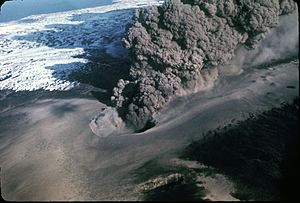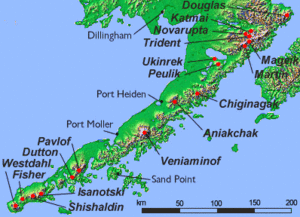Ukinrek Maars facts for kids
Quick facts for kids Ukinrek Maars |
|
|---|---|
| Highest point | |
| Elevation | 299 ft (91 m) |
| Geography | |
| Location | Becharof National Wildlife Refuge, Alaska, on Alaska Peninsula |
| Parent range | Aleutian Range |
| Geology | |
| Mountain type | Maars |
| Last eruption | March to April 1977 |
The Ukinrek Maars are two special volcanic craters in Alaska. They are found on the northern side of the Aleutian Range. This area is low and borders the Bering Sea.
These "maars" are like big, round holes in the ground. They formed when hot magma met water. This caused a powerful, explosive eruption.
Contents
Ukinrek Maars: Alaska's Explosive Lakes
The Ukinrek Maars are located about 1.5 kilometers (about 1 mile) south of Becharof Lake. They are also 12 kilometers (about 7.5 miles) northwest of Peulik Volcano.
What are Maars?
Maars are volcanic craters that form in a unique way. They happen when very hot magma deep underground meets groundwater. This contact creates a huge explosion of steam and ash. The explosion blasts a large, bowl-shaped hole in the ground. This hole often fills with water, forming a lake. The Ukinrek Maars are examples of these special volcanic features.
The Two Ukinrek Maars
There are two main Ukinrek Maars. They are called the west maar and the east maar.
The West Maar
The west maar has an oval shape. It is about 170 meters (558 feet) across. It is also about 35 meters (115 feet) deep.
The East Maar
The east maar is about 600 meters (1,968 feet) east of the west maar. This maar is round. It is larger, about 300 meters (984 feet) across. It is also deeper, at about 70 meters (230 feet) deep. Inside the east maar's crater lake, there is a lava dome. This dome is 49 meters (161 feet) tall.
The 1977 Eruption
The Ukinrek Maars had a big eruption in March and April of 1977. This eruption lasted for ten days. Before this, there had been no known eruptions from these maars.
The material that erupted was a type of rock called olivine basalt. This rock came from deep inside the Earth's mantle. The explosions sent out clouds of ash and rock. These clouds traveled mostly to the northwest.
A lot of material came out during the eruption. About 900,000 cubic meters (31.8 million cubic feet) of lava erupted. Also, about 26 million cubic meters (918 million cubic feet) of tephra was blasted out. Tephra is a general term for all the rock fragments and ash thrown into the air by a volcano.
Older Volcanic Activity Nearby
About three kilometers (about 2 miles) to the northeast are the Gas Rocks. These are older volcanic domes. Around 2,300 years ago, they also had an eruption. This was a "phreatic eruption." This type of eruption happens when hot water or steam explodes. It does not involve new magma reaching the surface.



